In an exclusive conversation, Joseph Kosinski, director of the F1 movie, reveals how the film captures the essence of Formula 1 racing while also incorporating IWC timepieces into the narrative. The partnership with IWC extends beyond simple branding, with specific models featured on characters and reflecting the fictional APXGP team’s identity. Kosinski emphasizes the importance of authenticity, noting the exceptional access granted to the film crew during real-life Grand Prix weekends, including the support of drivers like Lewis Hamilton.
Joseph Kosinski, how did you develop the idea for F1?
I have always been fascinated by cutting-edge machines and speed. After working with Navy jets on a carrier in Top Gun: Maverick, I realised that no one had ever made a movie about contemporary Formula 1 So, I developed this idea of making the most authentic racing movie that had ever been done.
What intrigues you about Formula 1?
Formula 1 is unlike anything else. When you are at a race, it feels like nothing exists outside of it. The creative and technical challenge of capturing the spirit and energy of this world intrigued me a lot. Formula 1 is also the only sport I can think of where your teammate can become your biggest rival, which makes for great drama.
You chose an in-camera filmmaking approach for this project. Why?
No matter how well visual effects are done, I believe the audience can feel it in their gut if something is real. There is a tactility and a special feel to reality. It has a soul. Obviously, the challenge of capturing Formula 1 driving is quite different from filming somebody in a jet. Also, for F1, we went one step further, because the actors are actually driving these cars themselves in many instances. When they are driving, you see them strain against the force of the wheel and pulling real g-forces in the corners. They are not acting. They are driving. And this makes the whole experience for the viewers so much different than if we had filmed it on a sound stage or solely with stunt drivers.
How come you worked with real race cars?
Toto Wolff, the CEO and Team Principal of the Mercedes AMG PETRONAS Formula One™ Team suggested that, rather than building a movie car and trying to make it fast, we should start with a race car and then build our film equipment into it. So, we ended up developing a car based on a Formula 2 chassis that would behave like a race car on the track but still be able to carry all this sophisticated equipment.
To capture the action, you engineered a completely new camera system. Existing cameras were too heavy and too big, so we had to engineer a completely new camera platform. It had to be light, so that it would not affect the performance of our race cars too much. But it also had to be small, so it would not obstruct the view of the drivers. To pan the cameras to the left and right, we engineered a compact and powerful motor. And a wireless network, positioned around the track, allowed us to control everything remotely. The whole process for developing and manufacturing our filming equipment and fitting it
into the cars lasted about 15 months.
How challenging was it to film during actual race weekends?
Shooting on the race weekends was an enormous challenge. It took years of planning and countless
rehearsals. When we were filming a scene on the starting grid, for example, we would have nine minutes in total, which allowed us a maximum of two or three takes. It was more like performing a live play on a stage in front of thousands of people. Everyone’s adrenaline is pumping, everyone feels the pressure.
Why are Formula 1 cars the ultimate machines?
The level of engineering and technology, but also the speed of the development, testing and manufacturing cycles in Formula 1, is insane. With F1, I also wanted to tell the story of the engineers and technicians who are working behind the scenes and around the clock on improving these cars and making them faster.
Tell us about your fascination for smaller machines – mechanical watches.
Like these bigger and more powerful machines I am drawn to, I am also intrigued by smaller machines like watches. They are so thoroughly engineered and thought-out down to the smallest details. And just like in a film that is shot with practical filmmaking in-camera, I think there is a soul in such a well-crafted timepiece.
What makes IWC Schaffhausen the perfect partner for F1?
The partnership with IWC is one of those collaborations that does not feel forced at all. For more than a decade, they have been the “Official Engineering Partner” of the Mercedes-AMG PETRONAS Formula One™ Team, which gives them this unique credibility in the sport. So, this partnership was an integral part of the filmmaking process.
How did you use IWC watches to support your story in the movie?
Watches are an important element in this film as they reflect aspects of the different characters that wear them. For example, IWC’s Pilot’s Watches were great for our pit crew, mechanics and engineers as they have a robust, technical look. Sonny Hayes (played by Brad Pitt) felt like he would have a vintage timepiece with a special character, so the modified Ingenieur SL from Gérald Genta was a
perfect match and felt like something that his father would have worn and given to him. For Damson Idris’ character Joshua Pearce, we chose a watch that combines performance with a look of exclusivity, just like Formula 1.
ALSO READ: 24 HOURS IN MILAN WITH IWC: SONNY HAYES WATCH REVEAL AND CMO CHAT WITH BURO.




